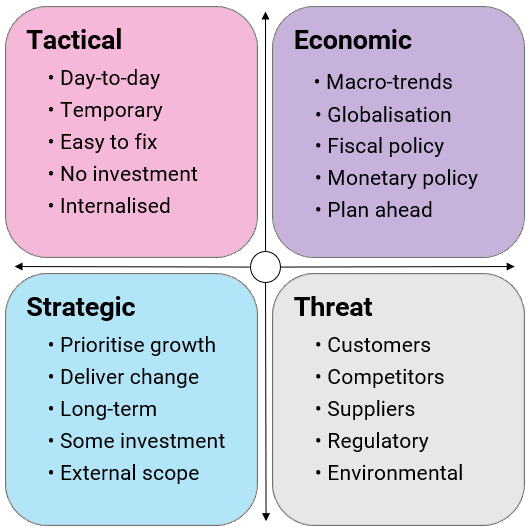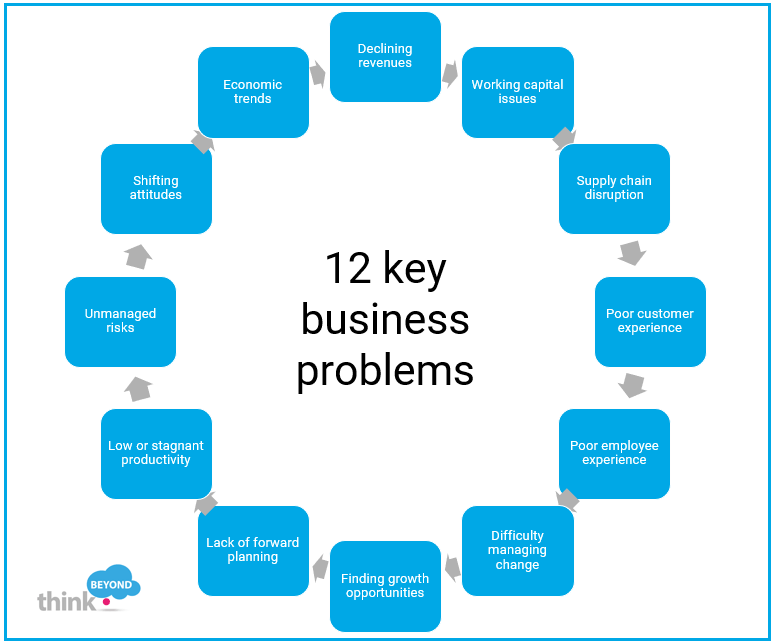Inevitably, things are changing. After years of Brexit uncertainty, more than two years of a pandemic and now war in Ukraine, nothing stays the same for long. Beneath these macroeconomic trends, we have the great resignation, changing attitudes and insolvencies. Yes, the sad truth is that corporate insolvencies are surging (March 2022 was +34% up on three years previously and more than double March 2021[1]) as creditors lose patience. In summary, business problems are mounting. Time to think about troubleshooting your business performance before its too late. Read on to find out more.
Business problems are nothing new
We tend to separate business problems into four types which we call TEST:
- Tactical – Business as usual, day-to-day issues running your business
- Economic – Macro-economic trends causing operating difficulties
- Strategic – Challenges to achieving growth or delivering change
- Threat – Customer, competitor, supplier, regulatory and environmental concerns
The scale and severity of business problems varies by industry. If you are having trouble with a delivery or a piece of equipment breaks, this is tactical. If you can no longer buy from a particular country or the currency flounders, this is economic. When business change is difficult or it appears impossible then this is strategic. Finally, if your main supplier becomes insolvent or customers boycott your products, this is a threat.

Fig 1. Types of business problem – Think Beyond TEST model
Business problem troubleshooting
Here are 12 key business problems to troubleshoot and solve:
- Declining revenues
- Working capital issues
- Supply chain disruption
- Poor customer experience
- Poor employee experience
- Difficulty managing change
- Finding growth opportunities
- Lack of forward planning
- Low or stagnant productivity
- Unmanaged risks
- Shifting attitudes
- Economic trends
For some businesses, it may seem as though the sheer number of business challenges is insurmountable. For others, it may seem as though you should be able to solve many of them but for many reasons cannot. Ultimately, there are many bumps in the road on the way to Rome. How you manage them and the capability within your organisation to overcome them are the two most important factors.

Fig 2. A radial view of 12 key business problems
Troubleshooting business problems
Is there a clear process for troubleshooting business problems? No, not really. Of course, there are a plethora of frameworks, models and tools to help in specific areas. However, addressing broader organisational underperformance is far from straightforward. Also, when someone throws a whole new mountain on your path to Rome, it presents a dilemma for senior leaders. Can we solve this with our resources? Do we have the skills and knowledge to solve this? Does the organisation have the capability to overcome a serious disruption? Is the organisational culture conducive to fixing broad underperformance?
Ultimately, there are a few things that you can do.
Solve from within
For organisations that are fortunate enough to have a depth of strength and breadth, the chances are that you can solve from within. Very large blue-chips can struggle with overwhelming complexity and inertia requiring external ‘crack teams’ to help get things moving. Others are already organised into agile teams to resolve customer problems for example. Smaller businesses may not have the skills in-house and it isn’t uncommon for existing staff to have a high level of utilisation. In these instances, it may be that progress is slower than desired or that some outcomes fall short of expectations.
Solve from outside
If the problem is large enough or the scale of transformation daunting enough, you may need an external team. Some of the largest global consultancies can deploy large teams across multiple locations. This is of course highly expensive and you pay for the privilege of this scale of deployment. For smaller businesses, it may help to find one or two specialists to parachute in and support internal teams. For mid-market corporates, it may be that different types of consultants are required to help in different areas. Either way, the trick is in matching the solution to the problem in the best ratio for the organisation.
Do nothing
No, we are not joking. This does appear to be a strategy for some businesses or leaders. We are not saying that it is a viable strategy or a recommended one but it still happens. Consider the perspective of a CEO with 1 or 2 years of tenure remaining. Is now the time to embark upon a major shake up of the organisation for which your successor will take the credit? Consider a company that has existed for 40 years and seen off every issue you could imagine. Could they have foreseen a pandemic, changes in the labour market and a war in Ukraine in quick succession? Consider that an ostrich remains at risk while its head is stuck in the sand.
Solving business problems
We are firm believers in research and planning. Armed with the right information on your market, customers and competitors, you can identify and prioritise opportunities. Furthermore, with well thought-out goals and thorough planning, we can identify the best courses of action and build organisational capability. In essence, this acts as a kind of training and strategic vision to spot and react to future challenges. Building organisational capability is essential to rebuff future uncertainty. Many leaders talk about the ‘good learning’ that came from the pandemic and other sources of disruption. Broadly speaking, this is code for “blimey, that was a tough time now that you mention it”. Being prepared means that the next bump in the road is absorbed more easily and smoothly than before.
One option for troubleshooting problems
We offer research, planning and change services to enable accelerated time to value. Our range of research services help you to identify strategic goals such as growth opportunities and to spot risks before they materialise. Our specialist business planning services help you to troubleshoot and prepare your business to capitalise on opportunities with the capability required to execute. Finally, our change and transformation services support your journey towards your strategic goals with specific tools to increase performance.
If you would like to speak to one of our team, please pop in a few details online.
Alternatively, simply email us at sales@think-beyond.co.uk or call us direct on 01565 632206.
Finally, why not read our recent article about consumer trends.

